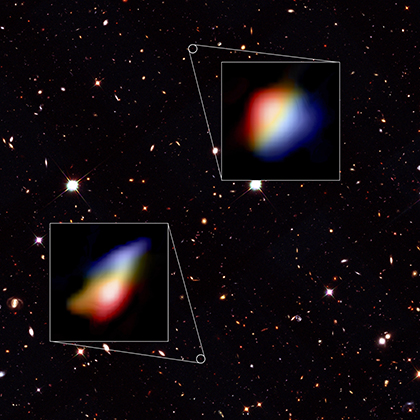Astronomers Detect Whirlpool Movement in Early Galaxies
Very far from the Earth and therefore difficult to observe, the first galaxies of the Universe were formed just after its birth. Nicknamed "baby-galaxies", they still remain mysterious. An international team of astronomers led by the University of Cambridge, including the University of Geneva (UNIGE), was able to measure their movement for the first time. Observed nearly 13 billion light-years from Earth, they swirled around their center in a similar way to the Milky Way. This discovery suggests that the gas contained in these newly formed galaxies already revolved around their center, like the "adult" galaxies resulting from the fusion and the growth of these galaxies. These results are published in the journal Nature.

Two galaxies as they appeared 800 million years after the Big Bang (only 6% of the current age of the Universe), observed thanks to ALMA. The color gradient shows the movement of the gas detected by ALMA, which reveals a rotation.
Crédits : Hubble (NASA/ESA), ALMA (ESO/NAOJ/NRAO), P. Oesch (University of Geneva) and R. Smit (University of Cambridge.
"It's a surprise, we expected these early galaxies to be very turbulent because of the frequent mergers between them and the chaos caused by the explosion of supernovae, many at that time," says Pascal Oesch, associate professor at Department of Astronomy of the Faculty of Sciences of UNIGE and co-author of the study. "But it turns out that these galaxies were already relatively ordered, although they had appeared so early in the history of the Universe. These "baby-galaxies", which were five times smaller than ours, were able to grow rapidly to become adults, like the one in which we are today, the Milky Way.
January 10, 2018
News
